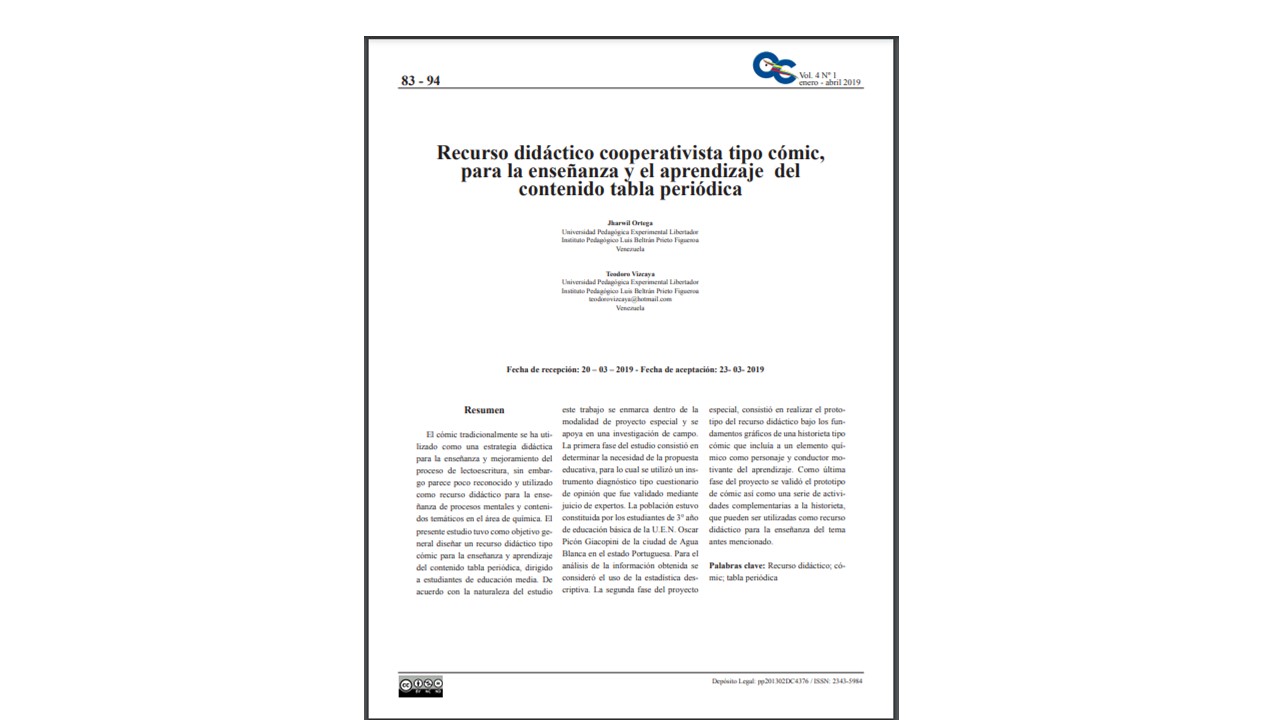Teaching cooperative teaching resource comic type, for teaching and learning the content periodic table
Keywords:
didactic resource, comic, periodic tableAbstract
The comic has traditionally been used as a didactic strategy for teaching and improving the literacy process, however it seems little recognized and used as a didactic resource for the teaching of mental processes and thematic contents in the area of chemistry. The general objective of this study was to design a comic-type didactic resource for the teaching and learning of the periodic table content, aimed at middle school students. According to the nature of the study, this work is part of the special project modality and is based on field research. The first phase of the study consisted of determining the need for the educational proposal, for which a diagnostic instrument type opinion questionnaire was used that was validated by expert judgment. The population was constituted by the students of 3rd year of basic education of the U.E.N. Oscar Picón Giacopini from the city of Agua Blanca in the Portuguese state. For the analysis of the information obtained, the use of descriptive statistics was considered. The second phase of the special project, consisted in making the prototype of the didactic resource under the graphic foundations of a comic-type cartoon that included a chemical element as a character and motivating driver of learning. As a last phase of the project, the comic prototype was validated as well as a series of complementary activities to the cartoon, which can be used as a didactic resource for teaching the aforementioned subject.
Downloads
References
Arango, J., Gómez, L. y Gómez, M. (2009). El cómic es cosa seria. Anagramas, 7 (14), 13–32.
Artacho, C. (2002). ¿Deben estar los cómics en las bibliotecas? Boletín de la Asociación Andaluza de Bibliotecarios, 17 (69), 57-72.
Aumont, J. (1992). La imagen. Barcelona, España: Paidós.
Cammaroto, A., Martins, F. y Palella, S. (2003). Análisis de las estrategias instruccionales empleadas por los profesores del área de matemática. Caso: Universidad Simón Bolívar. Sede litoral. Investigación y Postgrado, 18 (1), 71-85.
Campanario, J. (2004). Algunas posibilidades del artículo de investigación como recurso didáctico orientado a cuestionar ideas inadecuadas sobre la ciencia. Revista electrónica de enseñanza de las ciencias. 22 (3) 365-378.
Díaz Barriga, F. y Hernández, G. (2002). Estrategias Docentes para un aprendizaje significativo. México: McGraw Hill.
Fondo de las Naciones Unidas para la Infancia. UNICEF. (2003). Guía metodológica de validación de materiales IEC. Ministerio de Salud del Perú.
González, F. (1996). Proyectos Especiales. Ideas para su Conceptualización. Revista Investigación y Postgrado, 11(1); 127-144.
Gonçalves, R. (2010). Una evaluación preliminar de la lectura de textos de ciencias de diferentes géneros. Revista electrónica de enseñanza de las ciencias. 9 (2). 376-395.
Gubern, R. (1974). El lenguaje de los cómics. Barcelona, España: Ediciones Península.
Jiménez, G., Llithjós, A. (2006). Cooperación en entornos telemáticos y la enseñanza de la química. Revista Eureka sobre Enseñanza y Divulgación de las Ciencias, 3(1); 115-133.
Jiménez, G., Llobera, R. y Llitjós, A. (2006). La atención a la diversidad en las prácticas de laboratorio de química: los niveles de abertura. Enseñanza de las Ciencias, 24(1); 59-70.
Johnson, D. y Johnson, R. (1999): Aprender juntos y solos. Buenos Aires: Aique.
Lucci, M. (2006). La propuesta de Vygotsky: La psicología socio-histórica. Profesorado. Revista de Currículum y Formación del Profesorado. 10 (2), 1-11.
Morales Bueno, P. (2012). Uso de cómics como recurso didáctico en una estrategia de aprendizaje activo de la ciencia. Enseñanza y divulgación de la Química y la Física.
Madrid: Garceta Grupo editorial
Moya, A. (2010). Recursos didácticos en la enseñanza. Innovación y experiencias educativas. 6 (45) 1-9.
Pedrós, G. Martínez, M. y Varo, M. (2007). La sección de cartas al editor: un planteamiento científico y social en la didáctica de las ciencias. Enseñanza de las Ciencias. 25 (2), 195-204.
Roberts, R. (2004). Serendipia. Descubrimientos accidentales en la ciencia. Madrid: Alianza.
Sanmartí, N. (2006). Enseñar y aprender Ciencias: algunas reflexiones. España: Grau.
Savater, F. (2008). El valor de educar. Barcelona, España: Ariel.
Vallejos Díaz, Y. (2008). Forma de hacer un diagnóstico en la investigación científica. Perspectiva holística. Teoría y praxis investigativa, Volumen 3 (2), Septiembre – Diciembre, 11-22.
Wong, W. (1996). Fundamentos del diseño. Barcelona, España: Gustavo Gili, SA.

Downloads
Published
How to Cite
Issue
Section
License

This work is licensed under a Creative Commons Attribution-NoDerivatives 4.0 International License.







